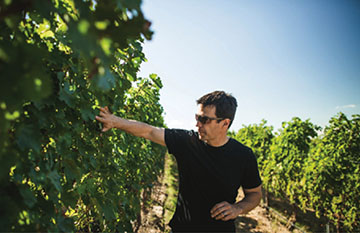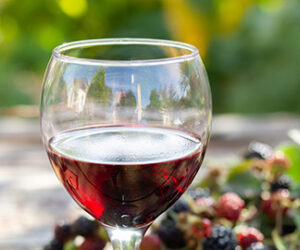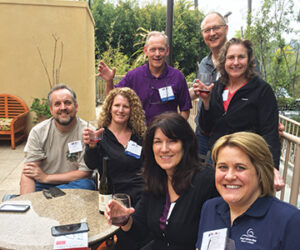 Consider the winemaker and the sommelier. Both are in the same industry but their jobs demand very different skills and can attract contrasting personality types. Greg Harrington, a former sommelier and now Winemaker at Gramercy Cellars in Walla Walla, Washington understands this separation:
Consider the winemaker and the sommelier. Both are in the same industry but their jobs demand very different skills and can attract contrasting personality types. Greg Harrington, a former sommelier and now Winemaker at Gramercy Cellars in Walla Walla, Washington understands this separation:
“I never thought I’d make the transition to winemaking because it seemed like there was a great divide between those who went to school to make wine and then those of us who went through a sommelier program,” he said.
And yet, in recent years, more sommeliers are crossing the divide and making very good wines. Harrington, a Master Sommelier, who has served wine in top class restaurants for chefs like Wolfgang Puck and Joyce Goldstein, says he was motivated to try winemaking on a wine tour of Walla Walla in 2004. At Pepper Bridge, one of Washington’s leading wineries, he found himself waxing lyrical over the Syrah. In response, pioneer winemaker Norm McKibbon invited him to come back and learn how to make it. Harrington accepted and that same year spent all the vacation time he had with McKibbon learning the craft.
Harrington’s romantic image of winemaking was soon dashed. “The biggest surprise of that first time was how intensely physical winemaking is, a contrast to the image of the winemaker wandering among his vines and tasting wine from barrels. You don’t see them cleaning tanks, dragging hoses and driving forklifts!”
But since then he hasn’t looked back. Gramercy Cellars, founded with his wife Pam and partner Brandon Moss, has produced wines that have attracted high praise from the wine establishment. Robert Parker scored the 2012 and 2013 vintages of ‘The Deuce’ Syrah at 93 and 94 respectively.
At about the same time as Harrington started to make wine, another sommelier, Rajat Parr, who runs the wine program for celebrity chef and restaurant empire builder Michael Mina, was also venturing into winemaking. Parr is perhaps best known for Secrets of the Sommeliers (2010, Ten Speed Press), co-written with food and wine
writer Jordan Mackay. The book, an insider’s look at the sommelier profession, won the 2011 James Beard Cookbook Award.
Parr spent about five years working with other winemakers who would make small batches of wine based on his vision. In 2009, he realized, “Nobody can actually do what you want to do, you’ve got to do it yourself.” In 2011 he founded Sandhi Wines and in 2013 he launched another Californian label, Domain de la Côte, where he makes estate-bottled wine from 40 acres of organically-farmed grapes.
The Calcutta-born winemaker’s efforts are also pleasing the critics. Recent vintages of his Pinot Noir and Chardonnay made from grapes sourced in California’s Central Valley, including the Santa Rita Hills, have scores in the 90s from Robert Parker and also Wine Spectator.
A Somm’s EYE view
One common thread that binds winemaking sommeliers: They have a very clear idea of what they want to make.
Kevin Vogt, described by Wine Spectator’s James Laube as a “superstar master sommelier” and “one of the most popular and congenial wine guys around,” bottles a single, Napa Valley Cabernet blend under the Mastery label he started a decade ago with wife Lynda. “I don’t really like anything overly inky; certainly restrained on oak. Just enough of everything without too much of anything,” explained Vogt of his preferred style of Cab. He just wrapped up nearly 20 years as Wine Director for the restaurants of celebrity chef Emeril Lagasse in Las Vegas. “A lot of people have the philosophy that more is better. For me more is not better. Better is better.” He said, adding that, more than anything, he tries to make wines with “beautiful balance.”
Harrington echoes this confidence, “I kind of know exactly what I want each wine to be in my head and for me it’s relatively to pick out the specific components that will give me exactly what I’m looking for.”
For the Gramercy Cellars founder and his colleagues that approach tends to be a more Old World approach to winemaking. “Most of the sommeliers [who also make wine] that I know are looking to make wines with higher acid, lower pH, and either no oak or very, very little oak.”
Harrington says his winemaking efforts try and stick to what he learned from studying in France’s Rhône region, including the use of native ferments, concrete tanks, and aging in large casks. By contrast, he says, winemakers trained at Washington State University or UC-Davis tend to approach winemaking from a more Californian perspective and aim for richer wines made from riper grapes that are more generous with oak.
These three somms also think their winemaking styles have profited considerably from their experiences as sommeliers.
“I think you really look at it [winemaking] a little more critically,” said Vogt, who blends his wines and determines how to age them but leaves the rest, including harvesting decisions, to winemaking consultant Rudy Zuidema.
Parr says the profession of sommelier has helped build his wine taste memory and facilitated meeting winemaking mentors. “I’ve been lucky to taste all the great wines of the world, meet the greatest winemakers in the world and go spend time with them in the cellars and in the vineyard,” he explained. “They taste my wines and advise me on things to do and not to do. I think that is invaluable.” However, he doesn’t think his knowledge of wines has actually helped his winemaking craft skills. “You know I don’t think it’s helped me make wine. Because in a sommelier’s world you want to control things and I’m the opposite, you don’t want to control anything in the cellar.”
Harrington says, apart from being fun, his sommelier profession has helped his winemaking in another fundamental way.
“It also helped me build an awesome network, you know when it comes time to selling. You know, making wine is the easy part, selling it’s the hard part!”
Techniques
Harrington, Vogt, and Parr say that great wine comes from using natural processes, including in the winery. For example, Harrington and Parr believe in minimal intervention and don’t use inoculated yeasts, enzymes like pectinase, or clearing and stabilizing agents. Parr doesn’t add nutrients to feed his yeast. Occasionally, Harrington says, they add diammonium phosphate (DAP) to help their yeast along.
The somms also respect the paramount importance of the vineyard with winemaking as an expression of vineyard site. But Parr said that he didn’t begin his winemaking career with this philosophy.
“Before I started making wine I thought, ‘Oh yeah, you get grapes and you make the wine and it should taste like you want it to taste,’ which is not true because the most important part is growing the grapes, finding the right vineyard, planting it correctly, farming it correctly. Making the wine is the easy part, growing the grapes is the hard part.”
For Parr, everything about when to harvest is based on tasting seeds, skin and pulp. “We taste a lot of grapes,” he said. “The key thing for us is acidity, the natural acidity.” Sugar levels aren’t something they worry about too much, instead, the decision to pick is based on finding a balance between the natural acidity and the sugar.
Harrington agrees. “For me, phenolic ripeness is not when Syrah tastes good but when the grape has this balance of acid and sugar.”
Gramercy harvest their grapes in the early morning or night, and rather than putting them through a crusher-destemmer, the winemaking process starts like it would have in Julius Caesar’s time: with foot stomping the grapes.
This ancient technique is not for kicks. Harrington insists that for his wine styles it works better than using a crusher or whole cluster fermentation. He explains: “We have enough fruitiness in Washington for Syrah. I’m trying to emphasize earthy flavors so I don’t want any carbonic maceration going on. If you just ferment whole cluster you can get a lot of intercellular carbonic maceration going on and I don’t want that happening. So I want to make sure all the berries are crushed up and exposed to the entire must that’s in the tank.”
Based on taste rather than signs of lignification, the stems are included in the fermentation too.
“We’ve noticed that stems either taste on the bitter side or the sweet side and, at least in Walla Walla, and I know this is true in northern Rhône as well, lignification has nothing to do with it,” said Harrington.
He says the method of using a destemmer for the grapes and then adding the stems back to the must is a bad idea. “That’s a recipe for disaster because what it does [destemming] is leave holes in the stem and you don’t actually want the flavor from the inside of the stem, you don’t want the sap, you want the flavor from the outside of the stem.”
To make their Syrah, Gramercy fill a 2-ton concrete tank halfway and foot-stomp it down and then repeat. They allow a natural fermentation to start that usually lasts about 21 days. For the first two days they do pump overs and then start punch downs on day three (with whole clusters they’ve found you can’t punch down in the early stages). During the first two weeks Harrington says they’ll punch down three times a day.
“As we get further into the fermentation I’m not worried about extraction anymore, it’s more about just keeping the cap wet and making sure we don’t get any volatile acidity (VA) or any other issues.”
During fermentations of their Rhône style wines, like the Syrah, they don’t do any temperature control, but Harrington likes this variety to ferment at between 80 and 85 °F (27 and 29 °C).
“Although I don’t mind a heat spike in Syrah,” he adds, “some of the best Syrah we’ve ever made has heat spiked to about 100 °F (38 °C); fortunately we didn’t kill the fermentation!”
He says when the fermentation peaks into the low or mid 90s Fahrenheit (~35 °C) it brings out some earthiness. At temperatures lower than 80 °F (27 °C) the style tends to be fruitier.
He says that they press their Syrah in separate lots at pressures of 0.5, 1 and 1.5. Harrington says there’s not usually much difference but the 1.5 press can add tannic flavors, which he likes. After that they allow the wine to settle in the tank for 24 to 48 hours.
“I don’t like coming straight out of the press pen and going straight to barrel because I find with gross lees Syrah can get extremely reductive and we’ve found that if you settle 24 to 48 hours you don’t have to rack at all,” he explained. “A lot of winemakers don’t believe me but we never have to rack it because we settle coming out of the press.”
Then the wine goes into 225-liter or 500-liter puncheons before being bottled between 15 and 18 months later. Generally, the warmer the vintage the earlier the bottling.
Parr also uses no temperature controls (except by punching down or pumping over) and says that during their natural fermentations the temperature of the cap can reach 95 °F (35 °C). He generally only uses sulfite directly before bottling. Until that stage, Parr says their must and wine is protected by their use of the whole cluster fermentation method (they don’t crush or destem their grapes).
“We do a lot of whole cluster [fermentations] so there’s still alcohol and dissolved CO2 in the tank and there’s also sugar left in the grapes,” he said. “So after you press there’s still sugar so it finishes fermenting in the barrels slowly.”
no going backSo now that they’ve made the transition from the dining room to the winery and vineyards, any chance of these somm’s going back to the restaurant life full time? While Vogt, Harrington, and Parr all said that they love their careers as sommeliers, winemaking is definitely a new frontier that they will continue to explore.
“All my friends that have done both, when they have a choice, end up doing the winemaking full time,” said Vogt. And these three somms are looking forward to many future vintages!







